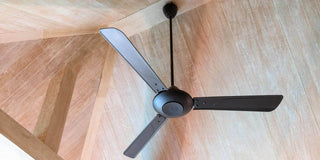In a hot place like Singapore, an effective way to beat the heat is to have a ceiling fan at home. Ceiling fans are considered staples in many households in Singapore. They are convenient to use and cost-effective to operate compared to other ventilation appliances. However, these hardworking ceiling fans can also encounter some issues, from unusual noise to problems with the fan’s operation.
We’ve listed some common ceiling fan or decken fan issues that may arise and some tips to address the problems at an early stage.
Common Ceiling Fan Problems and Solutions
Humming Noise

It is normal for a ceiling fan to produce some noise during its operation since its parts are bound to move. However, excessive noise from your ceiling fan can indicate some issues, like loose components that clang together during your ceiling fan’s operation or a lack of lubrication. If you have an older ceiling fan, chances are some screws have become loose due to micro vibrations.
Clean and examine your ceiling fan regularly to make sure that all screws are tightened and components are cleaned and lubricated. This will prevent rattling sounds and too much friction.
Ceiling Fan Light Issues

While not all ceiling fans feature a light kit, some models with this additional feature can also go through some wear and tear. Modern ceiling fans in Singapore feature LED lights that come with three light options: white, warm, and dim. These LED lights can help you save more electricity. Ceiling fan light flickering can be caused by a blown light bulb, a loose connection with the bulb, or a voltage issue.
If the cause of a flickering lightbulb is a fused bulb, the simplest solution is to change the bulb itself. However, if you notice your ceiling fan light flickering every time you use a major appliance like an oven or washing machine, you might have been experiencing a power fluctuation, which can only be fixed by a professional electrician.
Fanco Fan Repair Singapore: Fan Doesn’t Work While the Light Does

What should you do if your ceiling fan light is working while the fan itself does not? This issue is a clear indication of a problem within the ceiling fan unit. If your ceiling fan doesn’t turn on but its light fixture works normally, then this might be caused by malfunctions in your power supply. Depending on the degree of the issue, we highly suggest looking for a professional repair service to conduct the needed repairs. However, if your ceiling fan is old, it's time to get a replacement.
Remote Control Not Working

One of the best features that modern ceiling fans have is their remote controls. These remote controls not only help in operating the ceiling fan, but also encourage safety, especially in households with kids. However, if you have some issues with your remote control, you may also have a hard time operating your ceiling fan.
In case your ceiling fan remote control stops working, try replacing its batteries. However, if the battery is not the problem, the best solution is to get a new remote control.
Wobbly Ceiling Fan

One of the major concerns of homeowners when buying a ceiling fan is the safety of the installation. A wobbly ceiling fan can be caused by different reasons, including unbalanced or damaged blades, poor ceiling fan quality, or incorrect installation. You will need to address this issue as soon as possible to prevent further risks.
To avoid this issue, always buy a reputable brand with high-quality models and have them installed professionally. You can also request professional repair services to diagnose and repair problems as soon as possible.
Low Air Delivery

Another common ceiling fan issue is when it starts to run slowly and does not follow the speed that you set. This annoying issue can be caused by a lack of lubrication or a faulty ceiling fan motor. This can also be a result of a ceiling fan overheating. If you encounter problem where your ceiling fan high speed is slow, try checking your ball bearings to make sure that they are properly cleaned and lubricated. If your fan is running slower than usual or is stuck on a single speed, then you may need to replace its capacitor.
Ceiling Fan Not Turning On

There are many factors that cause your ceiling fan to stop working properly. These include electrical, loose wiring, or fan capacitor problems. This can also be caused by overheating or a tripped circuit breaker. Whatever the cause, the first thing that you should do is disconnect the ceiling fan from its power source to prevent any possible risks. You may contact your retailer to check the ceiling fan’s warranty so you can fix the damage more seamlessly.
In the event that your ceiling fan stopped working due to extreme damage or old age, weigh whether it is more efficient to have it repaired or replaced.
Overheating Ceiling Fan

If your ceiling fan is overheating, it can be an indication of possible issues with your fan motor. When your fan motor dries up and causes so much friction, the ceiling fan will heat up and, in turn, break or blow up. Ceiling fans in their best condition are specially designed to work for long hours. However, it is still important to let it rest to function well.
Tips and Precautions When Troubleshooting Your Ceiling Fan
Before Anything Else, Unplug Your Ceiling Fan

Before cleaning or going through the process of troubleshooting your ceiling fan problem, make sure that it is not connected to a source of electricity. This is to prevent accidents when checking your ceiling fan.
Familiarise Yourself With the Components of Your Fan

When troubleshooting your ceiling fan, it’s important that you are familiar with its parts to properly address the issue without the need to disassemble anything that is not needed. For the best results, let a professional handle the troubleshooting and repair.
Conclusion

Just like any other home appliance, your ceiling fan also requires proper care and maintenance. While it can be very helpful to many households, your favourite ceiling fan may also encounter some problems. Some of these can be easily solved, and some will require professional attention. It’s important to address the smallest ceiling fan issues right away to prevent bigger problems in the future. When it’s time to replace your ceiling fan, look for the best ceiling fans from reputable brands in Singapore.
Bonus Treat: Is Your Fanco remote control not working? Try these troubleshooting steps:
- Check Batteries: Replace the batteries in the fanco remote control to ensure it's not a simple power issue.
- Reset the Remote: Look for a reset button on the remote or remove the batteries for a minute, then reinsert them. This can sometimes refresh the connection.
- Check the Receiver: Ensure the receiver inside the fan canopy is properly connected and hasn't been dislodged or affected by dust.
- Interference: Eliminate potential interference from other wireless devices. Try using the remote closer to the fan or in different positions.
- Dip Switches: Check if the dip switches on the remote and the receiver are set to the same frequency. Misalignment can cause communication failures.
- Power Supply: Ensure the fan and the remote receiver are receiving power. Check the circuit breaker and any wall switches connected to the fan.
- Consult the Manual: Refer to your fan's manual for specific troubleshooting tips or reset procedures unique to your model.
- Contact Support: If the issue persists, contact Fanco customer support for further assistance or consider getting a replacement remote.



